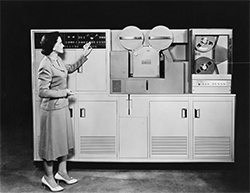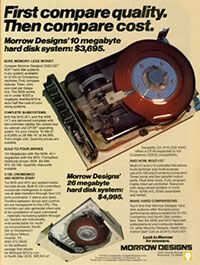Share this
The Evolution of Backup
by Mike Andrews on Sep 28, 2023 7:00:00 AM

At its core, backup has always been simply a method for returning to a prior state of productivity following an incident that has corrupted, deleted, encrypted, or otherwise separated us from our critical data. It's not this concept that has changed so much over the years. It's the massive technology advancements we've seen in the transmission, handling, and storage of data (not to mention the variety and quantity of it) that has made the greatest impact on how we think of the humble backup today.
The Early Days
 Sure, we can talk about handwritten copies of code, but the first real instances of modern data backup, as we know it, started with the mainframes of the 1950s. Highly manual, labor-intensive work, moving data between physically large, slow, and expensive storage media.
Sure, we can talk about handwritten copies of code, but the first real instances of modern data backup, as we know it, started with the mainframes of the 1950s. Highly manual, labor-intensive work, moving data between physically large, slow, and expensive storage media.
Engineers at this time had to develop their standards and methods for restoring backups. The basic concepts of creating multiple copies, which were carried out on a regular schedule, checking the integrity of backups, and documenting procedures were created. It seems basic by today's standards, but the practices and protocols developed at this time would lay the foundation for the strategies of today.
Types of Data Storage: Magnetic Tape, Punch Cards, Paper Tape, Magnetic Drums
Original Method: Physical Duplication
|
DID YOU KNOW... |
Floppy Disks: The Digital Revolution

The 1960s and 1970s arrived, ushering in the space age, and with it a leap in the amount of data generated & stored by the government, helping to launch us into a digital revolution. The new era of magnetic disks and early storage systems reduced the time-consuming processes and made backup more reliable for businesses.
Hard disks were a game-changer in that we saw fast, direct access to data through those lovely magnetic spinning platters. The iconic floppy disk made its debut, providing greater convenience, capacity, and, of course, mobility. The relatively low cost of tape drives made tape the medium of choice for large datasets, given their high capacity and long-term durability.
It was at this time that computer scientists and engineers began to formalize backup procedures, introducing wild new concepts like versioning and disaster recovery planning. We saw a shift towards automation for the first time, a monumental step forward in the history of backup.
New Types of Data Storage: Hard Disk Drives (HDD), Floppy Disks, Magnetic Tape Drives
New Methods: Backup Software, Manual and Automatic Backup, Disaster Recovery
|
DID YOU KNOW... |
Personal Computers and Networks
 As software evolved through the 1980s and 1990s, backup processes became increasingly automated. Rapid advances in drive miniaturization paved the way for personal computers to move from niche technology to everyday reality for businesses and individuals alike.
As software evolved through the 1980s and 1990s, backup processes became increasingly automated. Rapid advances in drive miniaturization paved the way for personal computers to move from niche technology to everyday reality for businesses and individuals alike.
The widespread adoption of the PC meant that personal data was being generated at an unprecedented rate and amount, from documents, spreadsheets, databases, and multimedia files. This in itself created a strong demand for data backup solutions to protect personal content. Consumers were writing to new types of media like CDs and Optical Disks, and consequently creating millions of coasters from their failed disk media. Ahh, the good old days.
As PC's started being connected in local area networks (LANs), and later the internet, the need for network-based backup solutions was realized. The environment was perfect for the creation of a centrally managed backup. New network backup software introduced methods like differential and incremental backups over the network, including encryption for the first time.
We saw a standardization in backup protocols, such as Network Data Management Protocol (NDMP), for communication between backup servers and popular new storage devices such as NAS (Network Attached Storage).
New Types of Data Storage: CDs, DVDs, Optical Disks, Offsite Storage, NAS, WAN
New Methods: Differential & Incremental Network Backup, Centralized Backup, Encryption
|
DID YOU KNOW... |
The Information Age

By the time we hit the 2000s and 2010s, the digital information age had really reached its stride. The generation of data continued to explode, and the ability to analyze big data meant organizations could make key decisions based on it.
On the business side, we saw Virtual Tape Libraries (HDDs emulating tape) vastly improving transfer rates and fast access to backups. On the consumer side, we saw NAS devices become affordable and used widely as a backup destination. The advent of Solid State Drives (SSDs) meant faster access to data for the consumer and reduced backup windows. Affordable Flash Drives brought new data mobility, and with it, the potential for new threats.
Most importantly, the global adoption of the Internet made the possibility of off-site backup more accessible and affordable. New online services started popping up, offering the ability to sync files to cloud locations, and we witnessed the birth of the first true Managed Service Providers.
Continuous Data Protection (CDP) services started to emerge, offering near real-time capture of the changes to data. Businesses and workers embraced increasing freedom, and the role of mobile devices (and how to secure them) also came to the forefront.
New Types of Data Storage: Virtual Tape Libraries, SSD, Flash Drives, Flash Storage Arrays
New Methods: Disk-to-disk (D2D) Backup, Continuous Data Protection (CDP), VM Backup
|
DID YOU KNOW... |
Backup Today
 Today, we see that the cloud has become an integral tool in data security, offering flexible access and scalability to protect against data events such as hardware failures, local disasters, and ransomware attacks. Both individuals and organizations can take advantage of low-cost local storage while also embracing the convenience and flexibility of cloud storage.
Today, we see that the cloud has become an integral tool in data security, offering flexible access and scalability to protect against data events such as hardware failures, local disasters, and ransomware attacks. Both individuals and organizations can take advantage of low-cost local storage while also embracing the convenience and flexibility of cloud storage.
Today's backup solutions have evolved to seamlessly protect data across multiple cloud environments in addition to on-site storage infrastructure, and are designed to help organizations meet new regulatory compliance requirements to ensure that sensitive data is protected and retained following the latest data privacy regulations.
Regarding access to backups, a Zero Trust security approach is often taken, requiring continuous authentication and authorization. Some backup solutions have even introduced immutability features, preventing backups from being altered or deleted to safeguard them from external tampering.
Highly focused backup solutions like NovaBACKUP have made it relatively easy to back up critical data, including unlimited local backup, built-in cloud backup capabilities, and even the option to add a (NAS-based) backup appliance.
New Types of Data Storage: Secure Cloud Storage, Object storage (Amazon S3, Azure Blob Storage, Google Cloud)
New Methods: Hybrid Backup, Immutable Backups, Backup Appliances
Looking forward: Automation and AI
AI will take on new time-consuming tasks, such as helping to analyze data to identify and separate critical from less important files, making prioritization much easier. It will also help make backups more efficient, reducing the amount of storage needed. We can also imagine AI helping to make backup schedules more dynamic, initiating backup jobs when there's a sudden increase in volume or other important triggers.
Automation will continue to improve, further streamlining backup processes and leaving less open to the likelihood of human error.
Conclusion
The ability to promise recoverability when you need it most has always been a moving target. As technologies and threats rapidly evolve, so must our data protection strategies and practices. Understanding the evolution of backup and related processes helps us make informed decisions and, most importantly, anticipate and adapt to new technology trends.
The river of history sweeps us along, and it is our duty to swim.
- Winston Churchill
If you'd like to learn more about NovaBACKUP, our team of backup experts is available to consult with you one-on-one, offering helpful backup strategy tips. Request a call today.
Image sources for Vintage Ads:
https://carleton.ca/scs/vintage-computing/hallways-displays/hard-disk-drive-display/
Share this
- Pre-Sales Questions (91)
- Tips and Tricks (90)
- Industry News (37)
- Best Practices (36)
- Reseller / MSP (31)
- Security Threats / Ransomware (26)
- Disaster Recovery (24)
- Cloud Backup (22)
- Storage Technology (22)
- Compliance / HIPAA (20)
- Applications (18)
- Backup Videos (15)
- Virtual Environments (12)
- Technology Updates / Releases (7)
- Backup preparation (6)
- Infographics (5)
- Products (US) (4)
- Company (US) (1)
- Events (1)
- Events (US) (1)
- Unternehmen (1)
- December 2025 (2)
- November 2025 (1)
- October 2025 (2)
- September 2025 (1)
- August 2025 (1)
- July 2025 (1)
- June 2025 (2)
- May 2025 (2)
- April 2025 (2)
- March 2025 (1)
- February 2025 (2)
- January 2025 (2)
- December 2024 (1)
- November 2024 (2)
- October 2024 (1)
- September 2024 (2)
- August 2024 (1)
- July 2024 (2)
- June 2024 (3)
- May 2024 (1)
- April 2024 (2)
- March 2024 (3)
- February 2024 (2)
- January 2024 (1)
- December 2023 (1)
- November 2023 (1)
- October 2023 (1)
- September 2023 (1)
- August 2023 (1)
- July 2023 (1)
- May 2023 (1)
- March 2023 (3)
- February 2023 (2)
- January 2023 (1)
- December 2022 (1)
- November 2022 (2)
- October 2022 (2)
- September 2022 (1)
- July 2022 (1)
- June 2022 (1)
- April 2022 (1)
- March 2022 (2)
- February 2022 (1)
- January 2022 (1)
- December 2021 (1)
- September 2021 (1)
- August 2021 (1)
- July 2021 (1)
- June 2021 (1)
- May 2021 (2)
- April 2021 (1)
- March 2021 (1)
- February 2021 (1)
- January 2021 (1)
- December 2020 (1)
- November 2020 (1)
- October 2020 (1)
- September 2020 (3)
- August 2020 (2)
- July 2020 (1)
- June 2020 (1)
- May 2020 (1)
- April 2020 (1)
- March 2020 (2)
- February 2020 (2)
- January 2020 (2)
- December 2019 (1)
- November 2019 (1)
- October 2019 (1)
- August 2019 (1)
- July 2019 (1)
- June 2019 (1)
- April 2019 (1)
- January 2019 (1)
- September 2018 (1)
- August 2018 (3)
- July 2018 (2)
- June 2018 (2)
- April 2018 (2)
- March 2018 (1)
- February 2018 (1)
- January 2018 (2)
- December 2017 (1)
- September 2017 (1)
- May 2017 (2)
- April 2017 (4)
- March 2017 (4)
- February 2017 (1)
- January 2017 (1)
- December 2016 (1)
- October 2016 (2)
- August 2016 (3)
- July 2016 (1)
- June 2016 (2)
- May 2016 (6)
- April 2016 (5)
- February 2016 (1)
- January 2016 (7)
- December 2015 (6)
- November 2015 (2)
- October 2015 (5)
- September 2015 (1)
- July 2015 (1)
- June 2015 (2)
- May 2015 (1)
- April 2015 (3)
- March 2015 (3)
- February 2015 (3)
- October 2014 (2)
- September 2014 (6)
- August 2014 (4)
- July 2014 (4)
- June 2014 (3)
- May 2014 (2)
- April 2014 (3)
- March 2014 (4)
- February 2014 (5)
- January 2014 (5)
- December 2013 (4)
- October 2013 (6)
- September 2013 (1)

